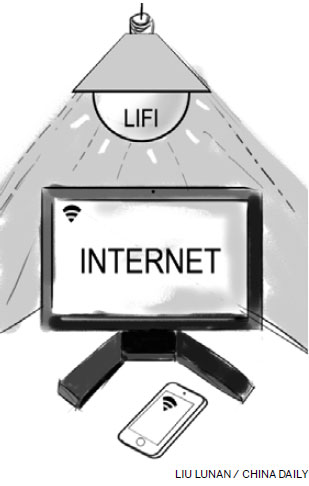

Surfing the Internet using light waves as easily as with Wi-Fi is not just a dream any longer.
A group of Chinese scientists recently succeeded in accelerating the speed of Internet access through light waves to a record high in a lab experiment.
According to the School of Information Science and Technology at Fudan University, researchers modulated Internet signals to a 1watt LED lamp. Under the light, four computers were able to access the Internet.
The offline maximum speed reached 3.7 Gb per second which, scientists said, is the world's fastest Internet access speed by LED light, while the average speed of a real-time system is up to 150 Mb/s.
"A video program was successfully delivered between two computers at this speed in our experiment," said Chi Nan, a professor from the University, who led the research.
The LED-based alternative to Wi-Fi, dubbed Li-Fi, or Light Fidelity, refers to a type of visible light communication technology that delivers a networked, mobile, high-speed communication solution in a similar manner to Wi-Fi.
As with radio waves, light is also a type of electromagnetic wave. The basic rule for sending and receiving Internet signals via light waves is similar to that for radio waves. Light-emitting diodes are switched on and off much faster than the eye can detect, which makes the light source appear to be continuous.
By adding a microchip to an LED bulb to control on and off switching, the data will flow as binary code: an on LED is a logical "1" while when off it is a logical "0".
"Wireless communication is mainly transmitted through traditional radio wave signals. Currently, the demand for wireless connection to the Internet is growing very fast," said Chi. "LED-based wireless communication exploits a new channel transmitting data."
China is working on replacing incandescent lamps with LED bulbs, which can be turned into Internet transmitters, she said.
The new technologies drew wide attention and excited great interest among netizens.
"It seems far more convenient. Where there is light, there is Internet signal. Even inside an aircraft, we can still connect to the Internet through the LED lights above our heads," wrote a netizen using the name LiuyunFeiwu.
Chi said the potential applications of such technology are enormous, but there is still much work to be done.
One question for Chi's research team is how large an LED light to install on the computer or mobile phone so as to support the data retrieval.
"The fundamental prerequisite for Li-Fi is a bi-directional link through a medium. It's obviously not practical to install a large light bulb on the computer," Chi said.
Another question is how to develop an applicable chip that works as a medium to send and receive data, she said.
Zhu Jie, an industry insider, who works in a telecom company, said: "Li-Fi can work as a supplement to the use of Wi-Fi, and to free the spectrum space. Compared with existing Wi-Fi technology, visible light communication is safer and causes less radiation."
"It may need quite a long time to apply to real life. The promotion of such technology may rely on the wide application in some certain fields," he added.
So far, Shanghai Municipal Science and Technology Commission is organizing the city's universities and research institutes to carry out the research and application work of such technology. Ten computers with Li-Fi technology will be displayed at the 2013 Shanghai International Industry Fair next month.
Copyright ©1999-2018
Chinanews.com. All rights reserved.
Reproduction in whole or in part without permission is prohibited.